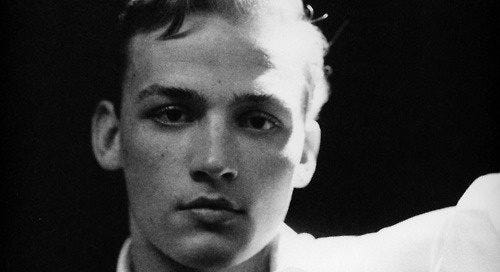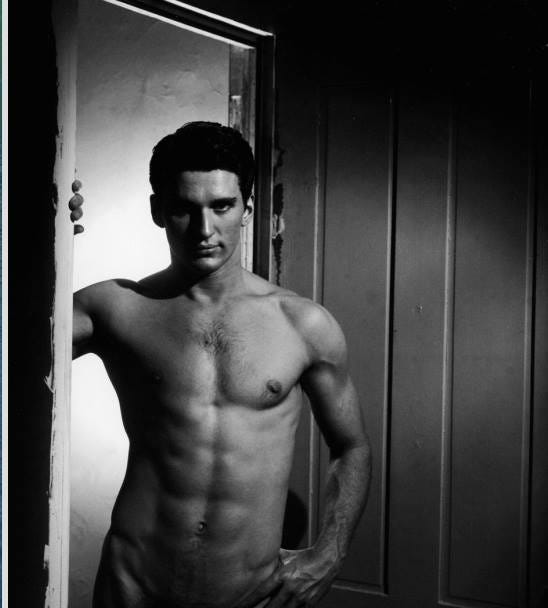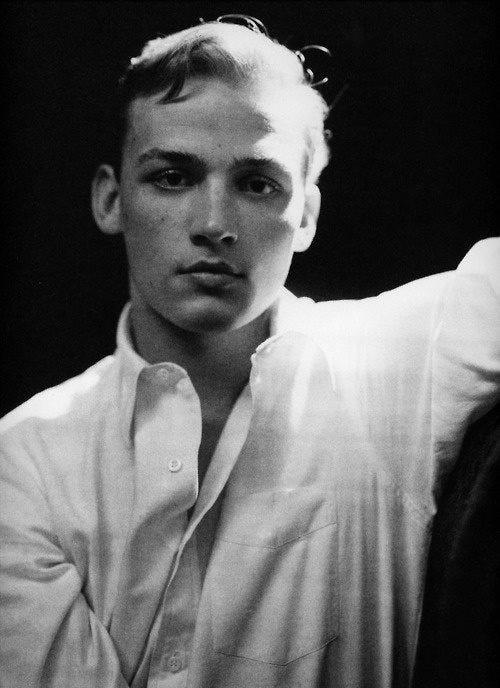This is a photograph of Bill Harris taken by George Platt Lynes, circa 1945. Harris was considered by many to be the most beautiful boy in New York and LA in the 1940s, and he was lovers with writer Christopher Isherwood. There were many other men after him, so many that Harris finally cried in front of Isherwood one night, “All this love…I can’t stand it!” By love, of course, he meant desire.
In his youth Harris was overlooked and all attention was paid to his athletic older brother, who was much-favored and very attractive. Harris was overweight in his early teens and thought of himself as “the ugly brother” until the age of 15, when he made a “decision” that he was going to be beautiful. The very sensitive Harris tried to serve in WWII, but he was discharged for bursting into tears after getting yelled at during an inspection. After the war, his older brother married, gained weight, and lost his looks, while Harris’s postwar beauty was much remarked-on; he was highly feminine, and many noted his resemblance to Marlene Dietrich.
Isherwood wrote in Lost Years: A Memoir, 1945-1951 that when he first saw Harris that the erotic shock hit him “like an elephant gun” and made him “grunt with desire.” Though he was studying to be a monk and wanted to be celibate, Isherwood found that he couldn’t resist the perfect blond Harris, who “liked sex, the more of it the better.” Harris had a male ideal he called “Heathcliff,” and this Heathcliff of his had to be taller than him, which Isherwood was not, but Harris was obliging with Isherwood anyway, and Isherwood always found him polite, cheerful, and considerate. At one point, Isherwood insisted on making love to Harris in each room of Harris’s secluded apartment on La Cienega in Los Angeles, which Harris spoke of later to their mutual friend Denham Fouts, a noted male courtesan of this period.
Harris was also lovers with Jack Fontan, who was the “naked sailor” on Broadway in South Pacific. Here’s what Isherwood wrote about why Fontan earned this nickname: “The character Jack played was called Staff Sergeant Thomas Hassinger on the program, but he was already known to hundreds of queers as ‘The Naked Sailor.’ Wearing nothing but a pair of the shortest shorts, without underwear, Jack sprawled in the midst of the group which sang ‘What ain’t we got? We ain’t got dames’ - displaying nearly all of his large and magnificent body, including glimpses of his genitals.” It was director Joshua Logan who insisted on this, and he kept cutting Fontan’s shorts down to nearly nothing in rehearsal. When a few audience members complained, Logan snapped. “If they don’t want to see his balls, they can have their money returned.” Below is a photo that George Platt Lynes took of Fontan in 1954, slightly cropped, since this is a family website.
Harris happily told Isherwood about his domestic life with Fontan in Manhattan in the late fall of 1949, and it sounds very romantic and very sexy in the telling, two of the most beautiful young men of their time hiding out together and loving each other. Proud of Fontan’s beauty, Harris liked to keep a nude photo of Fontan taken by Lynes near his bed. (Fontan died in Palm Springs in 2008, after a 53-year relationship with his lover Ray Unger, with whom he owned and managed the Laguna Health Club.)
Harris later settled in New York with a wealthy Argentinian named Pancho Moraturi and worked as a commercial art retoucher. Isherwood’s long-time artist lover Don Bachardy told Isherwood biographer Katherine Bucknell that he paid Harris with amyl nitrate to let Isherwood stay at Harris’s London flat in 1970, so it sounds like Harris was still having fun. When I visited Bachardy in 2004 to pose for him and Harris’s name came up, Bachardy got quiet and seemed a bit jealous, which I thought was sweet.
Harris died in 1992. But the beauty of the photos he took with Lynes lets his beauty live forever. Imagine seeing Bill Harris on the street in Greenwich Village in 1945…on the beach at Santa Monica in 1946….







Looks a bit like a young Gore Vidal.